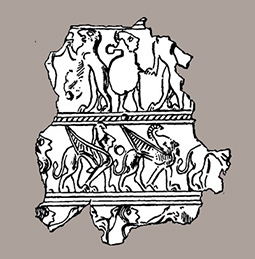scarica l’articolo in formato .pdf: A Bronze Belt from Kavousi
Questo lavoro ha l’obiettivo di riesaminare i frammenti in bronzo figurati rinvenuti all’interno di una tomba a tholos presso Kavousi (Creta) da Harriet Boyd nel 1900. Sin dai tempi del rinvenimento, la “Lamina di Kavousi” è stata al centro di numerosi studi relativi ai rapporti artistici e alle reciproche influenze tra l’Egeo, in particolare Creta, e il Vicino Oriente agli inizi del I millennio. Questo per via della ricca decorazione figurata che, disposta su registri paralleli, decora gli ampi frammenti bronzei con soggetti (signori degli animali, sfingi elmate, grifoni) cari al bagaglio figurativo orientale ma, al contempo, diffusamente attestati a Creta all’inizio dell’età del ferro. L’attenzione rivolta al programma figurativo della lamina bronzea, che trova confronti esatti in oggetti di varia natura provenienti da numerosi siti isolani, come Cnosso, l’antro Ideo, Eleutherna, Priniàs, ha fatto sì che nel tempo si trascurasse l’importanza della ricostruzione dell’oggetto in sé, rinunciando così ad un tassello importante e fondamentale nella ricostruzione del suo significato. Attraverso l’esame degli elementi figurativi, delle linee di frattura dei frammenti e della singolare disposizione dei fori sulla lamina, e grazie a confronti sistematici con la produzione coeva nel mondo vicino-orientale, si ritiene possibile ricostruire la “lamina in bronzo di Kavousi” con una cintura del tipo originato in Urartu tra fine del IX e l’inizio dell’VIII secolo a.C., e poi diffuso nelle regioni orientali e nel Mediterraneo.
This work is aimed to re-analyse figured bronze fragments found in the tholos tomb at Kavousi (Crete) by Harriet Boyd in 1900. Since the time of the discovery, the “Kavousi Bronze Plaque” was at the centre of several studies concerning artistic relationships and reciprocal influences between Aegean, Crete in particular, and Near East in the early 1st millennium BC. Interest was mostly addressed to the rich figural decoration through parallel registers, formed by subjects (lords of the animals, sphinxes, griffins) belonging to the Oriental iconographic repertoire but, contemporaneously, well attested in early Iron Age Crete. The attention focused on the plate’s decorative pattern, which has comparisons from other sites of the island (Knossos, Idaean Cave, Eleutherna, Prinias) made almost neglected the nature of the object itself, fundamental for the reconstruction of its meaning. Through the exam of decorative features, the fragments’ borders and the characteristic distribution of the holes along the plate’s rims, and thanks to systematic comparisons with the contemporary Eastern production, it is possible and plausible as well to reconstruct the “Kavousi plate” as a belt. This would be inspired by a Urartian prototype of 9th/8th cent. BC, later quite spread though neighbour Eastern Mediterranean regions.

